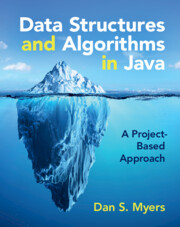Refine search
Actions for selected content:
48569 results in Computer Science
STEP: toward a semantics-aware framework for monitoring community-scale infrastructure
- Part of
-
- Journal:
- Data-Centric Engineering / Volume 5 / 2024
- Published online by Cambridge University Press:
- 20 December 2024, e44
-
- Article
-
- You have access
- Open access
- HTML
- Export citation
Graph-based information management for retrofitting long-living assets
-
- Journal:
- Data-Centric Engineering / Volume 5 / 2024
- Published online by Cambridge University Press:
- 20 December 2024, e46
-
- Article
-
- You have access
- Open access
- HTML
- Export citation

Data Structures and Algorithms in Java
- A Project-Based Approach
-
- Published online:
- 19 December 2024
- Print publication:
- 31 October 2024
-
- Textbook
- Export citation

Legal Design
- Dignifying People in Legal Systems
-
- Published online:
- 19 December 2024
- Print publication:
- 19 December 2024
Copyright page
-
- Book:
- Legal Design
- Published online:
- 19 December 2024
- Print publication:
- 19 December 2024, pp iv-iv
-
- Chapter
- Export citation
Contents
-
- Book:
- Internet Cures
- Published by:
- Bristol University Press
- Published online:
- 12 April 2025
- Print publication:
- 19 December 2024, pp v-v
-
- Chapter
- Export citation
I - Why Legal Design
-
- Book:
- Legal Design
- Published online:
- 19 December 2024
- Print publication:
- 19 December 2024, pp 9-58
-
- Chapter
- Export citation
Epilogue: Curing at the Digital Edge
-
- Book:
- Internet Cures
- Published by:
- Bristol University Press
- Published online:
- 12 April 2025
- Print publication:
- 19 December 2024, pp 131-133
-
- Chapter
- Export citation
6 - If It’s Worth Doing, It’s Worth Doing Live: Livestreaming Miracles
-
- Book:
- Internet Cures
- Published by:
- Bristol University Press
- Published online:
- 12 April 2025
- Print publication:
- 19 December 2024, pp 101-118
-
- Chapter
- Export citation
23 - Navigating in a Post-Quantum Legal Design Landscape
- from IV - Where Legal Design Goes
-
-
- Book:
- Legal Design
- Published online:
- 19 December 2024
- Print publication:
- 19 December 2024, pp 355-369
-
- Chapter
- Export citation
15 - Graphically Novel
- from III - How Legal Design Works
-
-
- Book:
- Legal Design
- Published online:
- 19 December 2024
- Print publication:
- 19 December 2024, pp 238-250
-
- Chapter
- Export citation
Introduction
-
-
- Book:
- Legal Design
- Published online:
- 19 December 2024
- Print publication:
- 19 December 2024, pp 1-8
-
- Chapter
- Export citation
13 - Teaching the Legal Inventors of the Future
- from III - How Legal Design Works
-
-
- Book:
- Legal Design
- Published online:
- 19 December 2024
- Print publication:
- 19 December 2024, pp 208-227
-
- Chapter
- Export citation
20 - The Open Law Lab Blog
- from III - How Legal Design Works
-
-
- Book:
- Legal Design
- Published online:
- 19 December 2024
- Print publication:
- 19 December 2024, pp 319-326
-
- Chapter
- Export citation
8 - Movement Lawyering
- from II - What Legal Design Can Do
-
-
- Book:
- Legal Design
- Published online:
- 19 December 2024
- Print publication:
- 19 December 2024, pp 118-133
-
- Chapter
- Export citation
Migration scenarios for gender apartheid and asylum: when International Criminal Law and International Refugee Law Meet
- Part of
-
- Journal:
- Data & Policy / Volume 6 / 2024
- Published online by Cambridge University Press:
- 19 December 2024, e77
-
- Article
-
- You have access
- Open access
- HTML
- Export citation
Part III - Digital Miracles as Digital Play
-
- Book:
- Internet Cures
- Published by:
- Bristol University Press
- Published online:
- 12 April 2025
- Print publication:
- 19 December 2024, pp 99-100
-
- Chapter
- Export citation
II - What Legal Design Can Do
-
- Book:
- Legal Design
- Published online:
- 19 December 2024
- Print publication:
- 19 December 2024, pp 59-176
-
- Chapter
- Export citation
3 - Dignifying Imagination in Legal Education
- from I - Why Legal Design
-
-
- Book:
- Legal Design
- Published online:
- 19 December 2024
- Print publication:
- 19 December 2024, pp 44-58
-
- Chapter
- Export citation
Part I - Contextualizing Internet Cures and Digital Miracles
-
- Book:
- Internet Cures
- Published by:
- Bristol University Press
- Published online:
- 12 April 2025
- Print publication:
- 19 December 2024, pp 13-14
-
- Chapter
- Export citation
